MSI GT627: Bringing Balance to the Force?
by Jarred Walton on April 29, 2009 4:00 AM EST- Posted in
- Laptops
Application Workloads: Overclocking FTW
Wrapping things up with our performance testing, we have results from the Futuremark PCMark suites as well as some of our own application benchmarking. When it comes to running your office, multimedia, and Internet tasks, most modern laptops are more than fast enough. What follows are a few of the more strenuous application benchmarks - 3D rendering and video encoding - that put more of an emphasis on high CPU speeds. If you don't do that sort of thing on your computer, you will probably find that just about any current dual-core processor is sufficient.
PCMark Vantage and CINEBENCH have 32-bit and 64-bit versions of the test suite available, with performance typically being 10% higher in CINEBENCH and 5% higher in PCMark Vantage. We have pulled the 64-bit results out of the graphs to clean things up, and since this is a 32-bit system we won't bother reporting the 64-bit results. You can find them in our last review, if you're interested. The Alienware m15x using the integrated X3100 is once again shown in gold on the PCMark tests, where the GPU still has an impact.
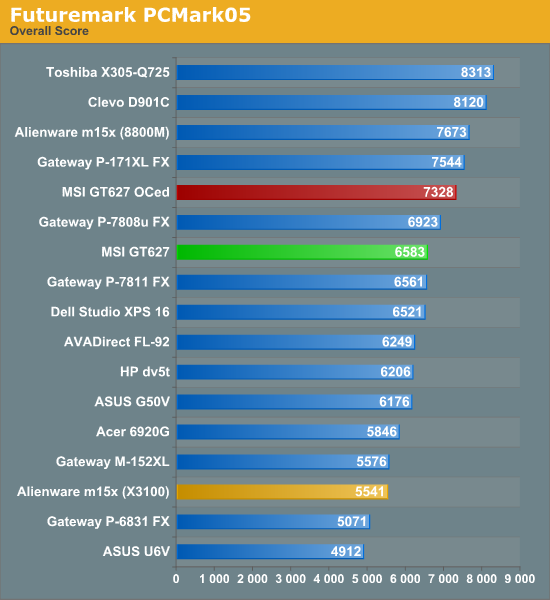
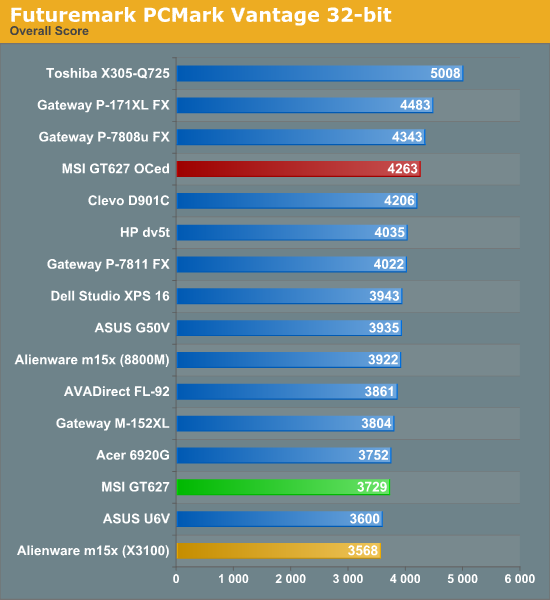

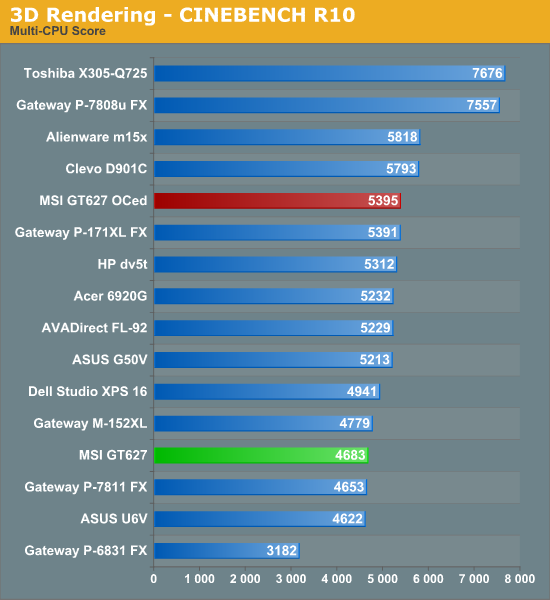
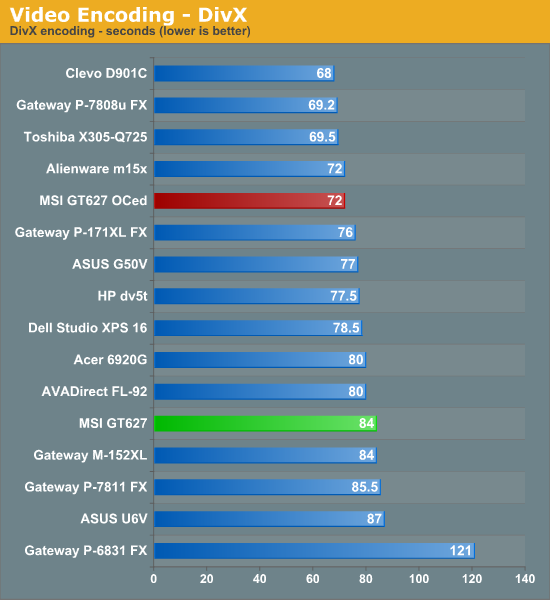
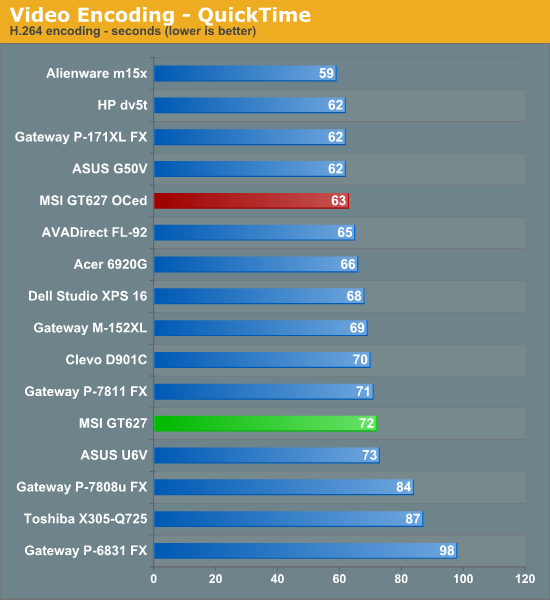


Stock performance places the GT627 near the bottom of the PCMark Vantage results (though admittedly only 16% behind the Gateway P-7808u), while it does better in the PCMark05 tests. PCMark05 represents a more "typical" usage scenario for most people, while Vantage stresses the system quite a bit more. Also note that the Toshiba X305-Q725 includes an SSD, which improves performance substantially in PCMark Vantage.
In the video encoding and 3D rendering tests, the GT627 places near the middle of the pack in performance, which you would expect from the P8400 processor. Not surprisingly, for all but the most demanding users the MSI GT627 is plenty fast - in fact, if you don't play games it's probably overkill. For CPU intensive tasks, the stock clocked GT627 is 22% to 23% slower in QuickTime and DivX encoding, but a far more substantial 75% slower in x264 encoding (the second pass, which is far more time consuming) and 64% slower in multi-core CINEBENCH.
Where things get interesting is in the overclocked results, where performance scales almost linearly in some applications with the 15% overclock. It's not enough to get the GT627 past quad-core options in highly threaded workloads, but it does surpass all but the fastest dual-core laptops. The P8400 is quite possibly the perfect CPU for such a laptop, coming in at a low price of around $210 for just the CPU but matching the performance of the T9400 when overclocked, a CPU that costs about $340. The final clock speeds and heat output at the overclocked speed of ~2.6GHz also appear to be well within the cooling capabilities of the chassis, as we never experienced any instability when utilizing the Turbo mode.










47 Comments
View All Comments
fwacct4 - Saturday, May 2, 2009 - link
I'm glad noise has been evaluated in this laptop review as well. Lots of stuff on desktop noise, but since I can't stick a laptop in a closet and still run it, fan noise on a laptop distracts me like nothing else. Even worse are laptop fan noise coming from people sitting near me.Rolling Camel - Friday, May 1, 2009 - link
I'm really looking forward to a GT725, it is the uber notebook below $2000, not Gateway. My A64 3000+ is really slow and i need a computer with enough graphics power. So either i get an Phenom 2 X3 and Hd4870 based system, or get the GT725. The desktop is cheaper and more powerful, but i need mobility for my school.I know the GT725 has some worries:
1.The keyboard, although there is a solution for it.
2.Many report that the track pad wears fast, as if i will ever use.
3.I'm worried about the thermal dissipation. The R770 seems more fit for the task.
4.Warranty and customer service.
The HD4670 equipped EX 625 is very tempting with it's $750 price tag.
ira176 - Friday, May 1, 2009 - link
Apple's batteries are custom made lithium polymer. They are not typical run of the mill lithium ion cells that most manufacturers use. Apple's batteries use all of the space in their design and have no "dead" space due to round cells packed in a rectangular battery as most win pc notebooks have. Although Apple's OS may be a little more conservative on battery usage it's got to be the mere fact that there's more capacity in their battery design, and maybe even cherry picked hardware and LED lcd displays. Win pc's could probably see better battery life with better battery designs and better part choices. Of course we would pay more for that pc notebook.JarredWalton - Friday, May 1, 2009 - link
Apples batteries are rated at between 40 Whr and 50 Whr in the current models - 40 for the Air, 45 for the standard MacBook, and 50 for the Pro if I'm not mistaken. The construction and material used in a battery does not affect the rating in Whr. If something is designed to output 5200 mA at 9.6V, it is a 50 Whr battery. A lithium polymer might be lighter for the total capacity, but I'm not talking about capacity.Given the above, it means that Apple's standard MacBook apparently consumes around 9.4W when surfing the Internet. In contrast, the ASUS U6V eats up 21W on average for the same task. I'm hoping to get a MacBook for a bit just to make sure there's nothing else going on, but Apple apparently uses less power surfing than most Vista PCs use at idle.
Zan Lynx - Friday, May 1, 2009 - link
From what I've gathered about it, Apple "cheats." They can turn hardware on and off and do clock scaling that isn't available via ACPI.JarredWalton - Friday, May 1, 2009 - link
Lenovo indicated to me at CES that they actually turn off components that aren't in use, which is how they improve battery life (supposedly - still waiting for a test sample). It makes sense that if your optical drive is inactive, completely shutting off power makes more sense than a .5W sleep state. They said they also power off the speakers when the sound is muted or when headphones are connected (another few hundred mW). I don't know about other devices, but really I don't care if it's "cheating" - custom designed hardware that functions better than the competition is fine as long as it works properly. Windows 7 is supposed to enable some better power savings (up to 11% better battery life I've heard), so we'll see.The0ne - Thursday, April 30, 2009 - link
If you're going to game on it why not just get one with 17" LCD? Better yet, get one with 1900x1200 and everything is just beautiful :)It's great that the article addresses the LCD issues. I mean come on, it's one of the main components when considering a laptop.
Rob94hawk - Thursday, April 30, 2009 - link
Where is this Clevo901c laptop?JarredWalton - Thursday, April 30, 2009 - link
I'm not sure what you mean. Do you mean where are the specs? If that's your question, the Sager NP9262 is a Clevo D901C chassis. Several other companies (WidowPC, AVADirect, Eurocom, etc.) use the Clevo chassis and rebrand it as their own, so I figured listing the original manufacturer in that case made the most sense.GoatMonkey - Wednesday, April 29, 2009 - link
The display on the MSI GT627 218US is apparently different, because it is listing max resolution of 1680x1050. I'd like to know if that display has better contrast ratio.Also, any news on the upcoming MSI GT628 with the nVidia M160?